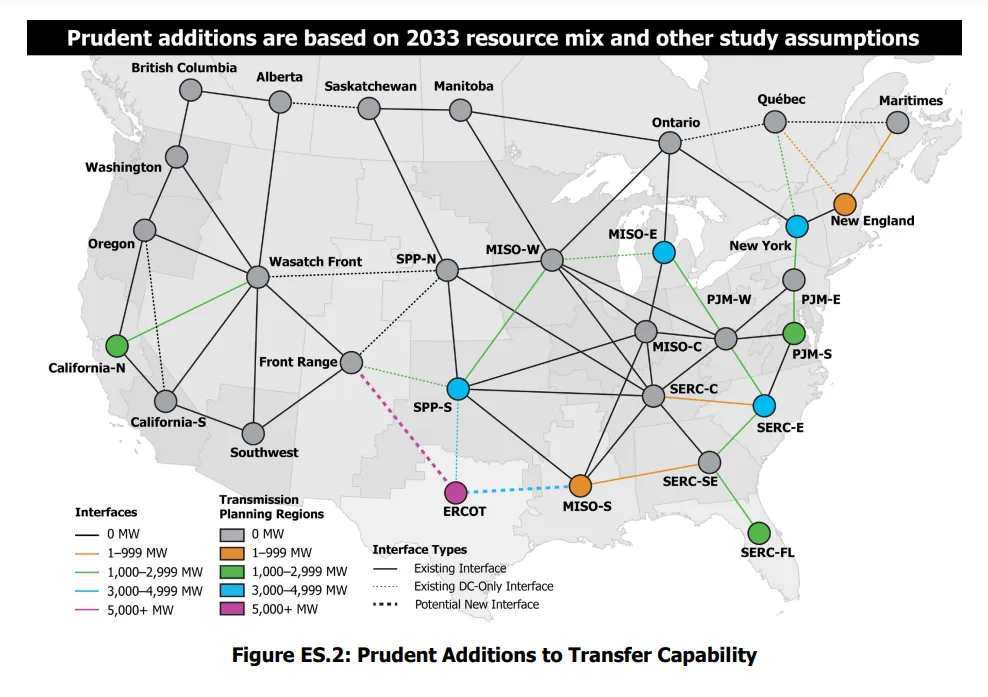Dive Brief:
- An additional 35 GW of electric power transfer capability between transmission planning regions would help to strengthen U.S. energy adequacy in extreme weather conditions and enable electrification and load growth, the North American Electric Reliability Corp. concluded in the second and third portions of a transmission study published Monday.
- NERC’s Interregional Transfer Capability Study, or ITCS, identified the potential for energy deficiency in 11 planning regions under some extreme weather scenarios, with a maximum resource deficiency of 19 GW in the Electric Reliability Council of Texas.
- Import capabilities required during extreme weather conditions varied significantly across the country, NERC said, and a “one-size-fits-all requirement” may be ineffective. “Transmission is a critical piece of North America’s reliability strategy, but it is only part of the solution,” said John Moura, NERC’s director of reliability assessment and performance analysis.
Dive Insight:
Adding additional transfer capacity between planning regions would strengthen the United States’ energy posture, but NERC’s report comes with caveats.
“The ITCS is the first-of-its-kind assessment of transmission transfer capability under a common set of assumptions but is not a transmission plan or blueprint,” the reliability watchdog said. The analysis does not include economic assessments, project-specific recommendations or a transmission expansion analysis.
The report “demonstrates a significant opportunity to optimize reserve use during extreme weather events and shows how transmission can maximize the use of local resources, including storage and demand response,” NERC said. “Further, the ITCS highlights the continuing importance of resource planning, as increasing transfer capability without surplus energy would be inefficient.”
NERC’s study evaluated the future energy adequacy of the bulk power system by applying 12 past weather years since 2009 to the expected 2033 load and resource mix, using the transfer capabilities calculated in the first part of the study.
In two planning regions, NERC said it “was not possible to eliminate all energy deficiencies, even by increasing transfer capability, due to wide-area resource shortages.” In ERCOT and California North, resource deficiencies remained even after NERC recommendations for increasing transfer capability by 14.1 GW and 1.1 GW, respectively.
The study also recommends adding 3.7 GW of transfer capability to New York; 3 GW to the Midcontinent Independent System Operator’s MISO-E region; 3.7 GW to Southwest Power Pool’s SPP-S; 2.8 GW to PJM Interconnection’s PJM-S; and 4.1 GW to SERC Reliability Corp’s SERC-E.

The amount of transfer capability needed to mitigate energy adequacy risk “varied significantly across the country,” NERC found. Some planning regions with relatively low transfer capability did not show resource deficiencies, while others with relatively high transfer capabilities did, the report said.
“This is a direct result of the unique challenges that face each TPR, such as its resource mix, each neighbor’s resource mix, and probable weather impacts,” NERC said. “Based on these findings, the ITCS concludes that a one-size-fits-all requirement for a minimum amount of transfer capability may be inefficient and potentially ineffective.”
Local generation or demand-side solutions can help to mitigate future energy risks alongside transmission additions, the report noted.
The ITCS “emphasizes a balanced approach — one that identifies the unique needs of each region and determines where targeted and meaningful investments can make a real difference in ensuring reliability and resilience,” Moura said.
Congress in 2023 directed NERC to recommend “technically prudent” additions of transfer capability between neighboring areas.
The two portions of the transfer capability study published Monday must be merged with an analysis published in August and sent to the Federal Energy Regulatory Commission by Dec. 2. An analysis and recommendations of transfer capabilities between the U.S. and Canada is expected to be published in the first quarter of next year.















